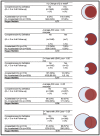Best performing definition of accelerated knee osteoarthritis: data from the Osteoarthritis Initiative
- PMID: 27721902
- PMCID: PMC5037496
- DOI: 10.1177/1759720X16658032
Best performing definition of accelerated knee osteoarthritis: data from the Osteoarthritis Initiative
Abstract
Background: We evaluated agreement among several definitions of accelerated knee osteoarthritis (AKOA) and construct validity by comparing their individual associations with injury, age, obesity, and knee pain.
Methods: We selected knees from the Osteoarthritis Initiative that had no radiographic knee osteoarthritis [Kellgren-Lawrence (KL) 0 or 1] at baseline and had high-quality quantitative medial joint space width (JSW) measures on two or more consecutive visits (n = 1655 knees, 1143 participants). Quantitative medial JSW was based on a semi-automated method and was location specific (x = 0.25). We compared six definitions of AKOA: stringent JSW (averaged): average JSW loss greater than 1.05 mm/year over 4 years; stringent JSW (consistent): JSW loss greater than 1.05 mm/year for at least 2 years; lenient JSW (averaged): average JSW loss greater than 0.25 mm/year over 4 years; lenient JSW (consistent): JSW loss greater than 0.25 mm/year for at least 2 years; comprehensive KL based: progression from no radiographic osteoarthritis to advance-stage osteoarthritis (KL 3 or 4; development of definite osteophyte and joint space narrowing) within 4 years; and lenient KL based: an increase of at least two KL grades within 4 years.
Results: Over 4 years the incidence rate of AKOA was 0.4%, 0.8%, 15.5%, 22.1%, 12.4%, and 7.2% based on the stringent JSW (averaged and consistent), lenient JSW (averaged and consistent), lenient KL-based definition, and comprehensive KL-based definition. All but one knee that met the stringent JSW definition also met the comprehensive KL-based definition. There was fair substantial agreement between the lenient JSW (averaged), lenient KL-based, and comprehensive KL-based definitions. A comprehensive KL-based definition led to larger effect sizes for injury, age, body mass index, and average pain over 4 years.
Conclusions: A comprehensive KL-based definition of AKOA may be ideal because it represents a broader definition of joint deterioration compared with those focused on just joint space or osteophytes alone.
Keywords: classification; knee; osteoarthritis; phenotype; radiography.
Conflict of interest statement
The authors declare that there is no conflict of interest.
Figures


References
-
- Bartlett S., Ling S., Mayo N., Scott S., Bingham C., 3rd (2011) Identifying common trajectories of joint space narrowing over two years in knee osteoarthritis. Arthritis Care Res 63: 1722–1728. - PubMed
Grants and funding
LinkOut - more resources
Full Text Sources
Other Literature Sources
Miscellaneous

